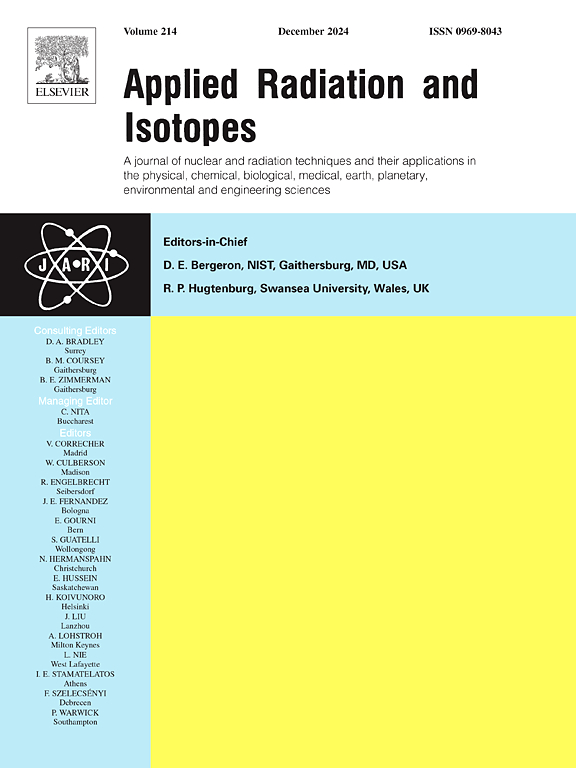基于加速器的硼中子俘获治疗胸部肿瘤的可行性研究:治疗计划方面
IF 1.6
3区 工程技术
Q3 CHEMISTRY, INORGANIC & NUCLEAR
引用次数: 0
摘要
本研究探讨了基于加速器的硼中子俘获疗法(AB-BNCT)治疗胸部肿瘤的可行性。14名患者入组:6名乳腺癌患者,5名肺癌患者,3名食道癌患者。虽然BNCT是在单一光束方向上进行单段治疗,但在未达到GTV剂量限制的情况下,采用不同光束角度的两段治疗被认为可以提高GTV的剂量。通过蒙特卡罗模拟(PHITS)计算基于计算机断层扫描(CT)图像的相对生物有效性(RBE)加权剂量分布,以评估对GTV和危险器官(OARs)的剂量。6例患者(乳腺:1例,肺:4例,食管:1例)由于肿瘤深部或较大,单场照射计划未能达到GTV的剂量限制,而其他患者则达到了。在这6例患者中,双场照射计划使GTV的剂量约束完成率从0例提高到5例,心脏的剂量约束完成率从5例提高到6例。此外,双场辐照方案提高了GTV的均匀性指数。根据患者的病情改变适当的剂量处方和治疗段数,可以在给予肿瘤足够剂量的同时,增强胸部肿瘤BNCT的安全输送。本文章由计算机程序翻译,如有差异,请以英文原文为准。
Feasibility study of accelerator-based boron neutron capture therapy for thoracic tumors: treatment planning aspect
This study discusses the feasibility of accelerator-based boron neutron capture therapy (AB-BNCT) for thoracic cancers. Fourteen patients were enrolled: six with breast cancer, five with lung cancer, and three with esophageal cancer. Although BNCT is performed with a single fraction from a single beam direction, two-fraction treatments with different beam angles were considered to improve the dose of gross tumor volume (GTV) in cases where the dose constraint of GTV was not achieved. Relative biological effectiveness (RBE)-weighted dose distributions were calculated based on computed tomography (CT) images via Monte Carlo simulation (PHITS) to evaluate the dose to GTV and organs-at-risk (OARs). One-field irradiation plans in six patients (breast: 1, lung: 4, esophageal: 1) did not achieve the dose constraint of GTV owing to deep-seated or large tumors, whereas those in the other patients did. Among these six patients, the two-field irradiation plan improved the achievement rate of the dose constraint of GTV from zero to five patients and that of heart from five to six patients. Moreover, the 2-field irradiation plan improved the homogeneity index of GTV. Changing the appropriate dose prescription and number of treatment fractions according to the patient's condition can enhance the safe delivery of BNCT for thoracic cancers while delivering a sufficient dose to the tumors.
求助全文
通过发布文献求助,成功后即可免费获取论文全文。
去求助
来源期刊

Applied Radiation and Isotopes
工程技术-核科学技术
CiteScore
3.00
自引率
12.50%
发文量
406
审稿时长
13.5 months
期刊介绍:
Applied Radiation and Isotopes provides a high quality medium for the publication of substantial, original and scientific and technological papers on the development and peaceful application of nuclear, radiation and radionuclide techniques in chemistry, physics, biochemistry, biology, medicine, security, engineering and in the earth, planetary and environmental sciences, all including dosimetry. Nuclear techniques are defined in the broadest sense and both experimental and theoretical papers are welcome. They include the development and use of α- and β-particles, X-rays and γ-rays, neutrons and other nuclear particles and radiations from all sources, including radionuclides, synchrotron sources, cyclotrons and reactors and from the natural environment.
The journal aims to publish papers with significance to an international audience, containing substantial novelty and scientific impact. The Editors reserve the rights to reject, with or without external review, papers that do not meet these criteria.
Papers dealing with radiation processing, i.e., where radiation is used to bring about a biological, chemical or physical change in a material, should be directed to our sister journal Radiation Physics and Chemistry.
 求助内容:
求助内容: 应助结果提醒方式:
应助结果提醒方式:


